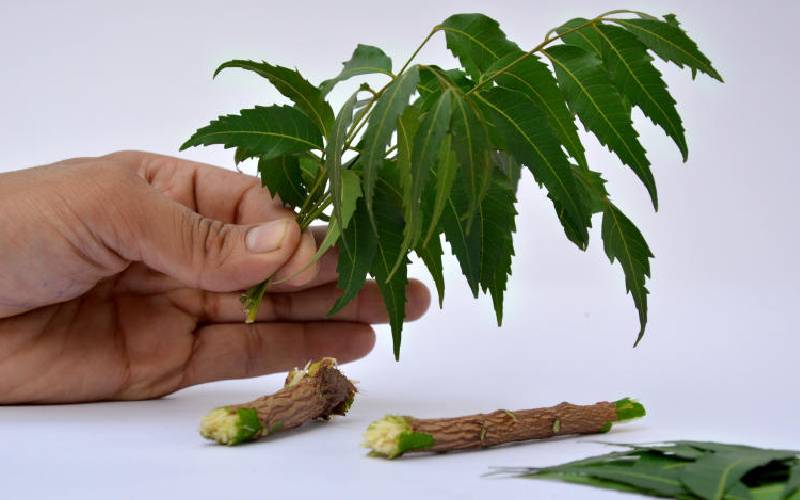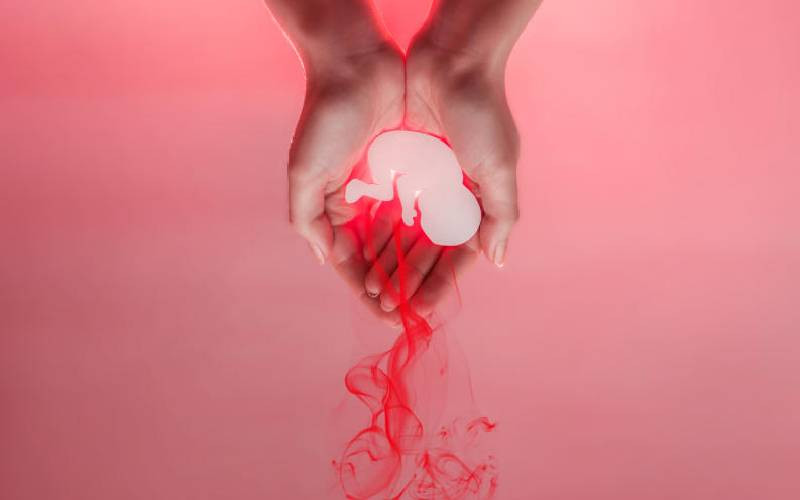
Neem tree. [File, Standard]
Sarah Aluoch of Sarafine Investments mixes the neem sachet with honey and boiled water which she drinks every day and gives to her children as well. Nobody advised her or prescribed to her to use neem tree dried leaves. She says she used to see her mother give her siblings boiled leaves whenever they had fever emanating from different conditions.
“It is interesting that this important medicinal plant, has not been recognised by many people in Nyanza, who use the tree for firewood, building poles for grass-thatched houses and for charcoal burning,” says Sarah.
Mwarubaini is derived from the word Arubaini, which means 40. This means Neem tree, called Mwarubaini in Kiswahili and Dwele in dholuo, can treat up to 40 different conditions.
“Other medicinal benefits of neem tree I have read about from the internet and some herbal science publications like African Medical News, Science Africa, Real Health News, Health Updates among others,” says Sarah. “I am quite sure my kids have not caught Covid-19 despite the fact that they are in school and play together with many different children.”
According to Mr Narshibhai M Ghedia of Kenya Laboratory Supply Centre, Neem (Azadirachta indica) is a tree native to the Indian subcontinent. Mr Ghedia says parts of this tree have long been utilised in traditional Asian medicine. He notes that historically, it has been used to treat pain, fever, and infection, while its twigs have been used to clean teeth as toothbrushes. Still, you may be curious to know whether any of these claims are merited. The active compounds have been isolated from various parts of the plant.
Dr Nicholas Ochieng’ of Kenyatta National Hospital says the bark, the leaves, and the seeds of the tree are used to make herbal medicine. Still, the roots, flowers, and fruits of the plant are also used to manage various ailments.
He notes that some people sometimes chew neem twigs and use it as toothbrush. This can cause illness such as stomach problem since twigs are often contaminated with fungi.
“That is why it should be mixed with water and boiled,” says agronomist Mr George Okwirry Lang’o.
Mr Ghedia says herbalists in India who are specialists in the use of traditional medicine use parts of neem tree like “the stem, root bark, and fruit are used as a tonic and astringent. Some people apply neem directly to the skin to kill head lice, skin diseases, wounds, and skin ulcers as well as mosquito repellent; and as a skin softener.”
Neem is also used as an insecticide. Some research suggests that applying neem leaf extract gel to the teeth and gums twice daily for six weeks reduces plaque formation. It also reduces the number of bacteria in the mouth that can cause plaque. However, using a mouth rinse containing neem extract for two weeks does not appear to reduce plaque or gingivitis.
Experts suggest that applying extract of neem root or leaf to the skin helps repels black flies. According to a retired dermatologist Dr Melanie Miyanji, taking neem extract by mouth along with daily sun exposure and the application of a coal tar and salicylic acid cream, reduces the severity of psoriasis symptoms.
However, when neem is taken in large doses or for long periods of time, it is becomes unsafe. It might harm the kidneys and liver. Children taking its seeds or oil by mouth are likely to vomit, diarrhoea, have drowsiness, blood disorders, seizures, loss of consciousness, coma and brain disorders.
When taken by mouth during pregnancy can cause a miscarriage. Not enough is known about the safety of neem during breast-feeding, say medical experts.
In auto-immune diseases such as multiple sclerosis (MS), lupus (systemic lupus erythematosus, SLE) or rheumatoid arthritis (RA), neem might cause the immune system to become more active worsening their symptoms.
There is some evidence that the plant can harm sperm. It might also reduce fertility in other ways. “If you are trying to have children, avoid using neem,” experts advise.
In a study that tested the efficacy of a neem-based shampoo on head lice in children, leaving shampoo in the hair for 10 minutes killed the lice while being gentle on the skin, a compound found in the plant’s oil, may also treat dandruff due to its anti-inflammatory and antimicrobial properties.
Experts say Neem seed oil is rich in fatty acids, including oleic, stearic, palmitic, and linoleic acids. Collectively, these fatty acids have been shown to have anti-inflammatory, antioxidant, and antimicrobial properties that promote good healthy skin.
Sarah’s believes her soft, shiny skin to be as a result of regular use neem tea leaves. She says since she started using the plant leaves she has never caught common cold, influenza, running nose and cough.
“Keep in mind that while Ayurvedic medicine — an Indian traditional healing system — uses neem to treat psoriasis and eczema” says Mr Ghedia.
Neem trees are found in abundance in coastal region, especially around Ukunda in Kwale County, in Nyanza and Western provinces where climatic conditions favour the growth of the plant.
 The Standard Group Plc is a multi-media organization with investments in media platforms spanning newspaper print
operations, television, radio broadcasting, digital and online services. The Standard Group is recognized as a
leading multi-media house in Kenya with a key influence in matters of national and international interest.
The Standard Group Plc is a multi-media organization with investments in media platforms spanning newspaper print
operations, television, radio broadcasting, digital and online services. The Standard Group is recognized as a
leading multi-media house in Kenya with a key influence in matters of national and international interest.











